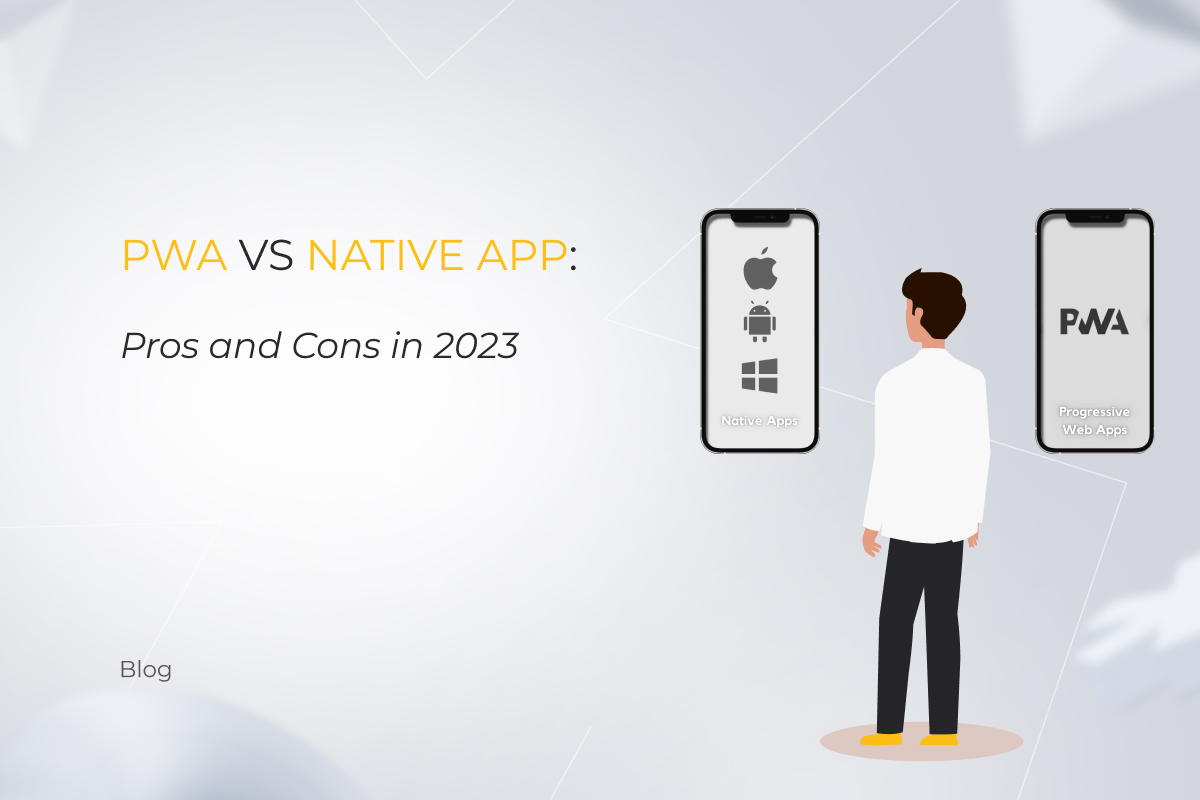Enterprises are rethinking how they deliver digital experiences to their customers. The choice between building separate native apps for iOS and Android or creating a single Progressive Web App (PWA) is no longer theoretical.
The PWA market is growing quickly, with one source projecting a compound annual growth rate (CAGR) of 31.1% between 2020 and 2030, driven by demand for modern digital solutions.The business case is simple. Why spend twice the money and time when one solution works everywhere?
PWAs blend the best of websites and mobile apps. They load instantly, work offline, and sit on your home screen like any other app. But they cost less to build and maintain than traditional mobile apps. For enterprises managing tight budgets and demanding timelines, this matters.
Gartner reports that companies using PWAs reduce their development costs by up to 60% compared to building separate native applications. That’s not a small number. It’s the difference between launching in three months or nine. Between allocating budget to marketing or burning it on duplicate development work.
The shift toward PWAs isn’t just about saving money. It’s about speed, reach, and user satisfaction. Businesses offering web app Development services are seeing increased demand for PWA solutions because enterprises want faster deployment without sacrificing quality.
This article explores why Fortune 500 companies and growing businesses alike are choosing PWAs. You’ll learn what makes them different, where they excel, and why they might be the right choice for your enterprise too.
What You’ll Learn
- How PWAs cut development and maintenance costs significantly
- Why PWAs deliver better performance than traditional mobile sites
- The offline capabilities that make PWAs reliable anywhere
- How PWAs improve user engagement and conversion rates
- Why SEO benefits give PWAs an edge over native apps
- Real examples of enterprises succeeding with PWA adoption
What Exactly Are Progressive Web Apps?
Think of it as a hybrid approach that combines web accessibility with app-like functionality.
PWAs use modern web technologies to deliver experiences users expect from mobile apps. They can send push notifications. They work offline. Users can install them on their home screens without visiting an app store.
But here’s the key difference: they’re built using standard web technologies. HTML, CSS, and JavaScript power them. This means one codebase works across all devices and platforms.
No separate iOS version. No Android-specific build. Just one application that adapts to any screen size or operating system.
The True Cost of Traditional App Development
Building native apps for multiple platforms is expensive. You need separate teams for iOS and Android development. Each platform has its own programming language, design guidelines, and testing requirements.
Let’s break down what this actually means.
An iOS app requires Swift or Objective-C developers. Android needs Java or Kotlin expertise. These are different skill sets, different tools, and different workflows. You’re essentially building two completely separate products that happen to do the same thing.
Then comes maintenance. Every feature update needs to be coded twice. Every bug fix requires work on both platforms. When Apple or Google updates their operating systems, both versions of your app need updates.
PWAs eliminate this duplication. One development team builds one application. Updates deploy instantly to all users. There’s no waiting for app store approval.
The math is straightforward. If native app development costs $200,000 for both platforms, a PWA might cost $80,000 to $100,000. That’s a 50-60% reduction in initial investment.
Performance That Actually Matters
Speed determines whether users stay or leave. PWAs load faster than traditional mobile websites because they use service workers to cache assets and data.
What does this mean in practice?
A service worker is a script that runs in the background. It intercepts network requests and serves cached content when possible. This makes the app feel instant, even on slow connections.
Traditional websites load everything from scratch on each visit. PWAs load once, then pull only new data. The difference is noticeable.
Studies show that a one-second delay in page load time can reduce conversions by 7%. PWAs solve this by pre-loading critical resources. Users see content immediately, not after a painful wait.
But it’s not just about initial load times.
PWAs maintain smooth performance during use. They prefetch likely next pages. They cache API responses intelligently. The experience feels responsive because the app anticipates what users need.
Offline Functionality Changes Everything
What happens when your users lose internet connection? With traditional websites, they see an error message. With native apps, features break if they require server communication.
PWAs work differently.
They store essential data and functionality locally. Users can browse previously loaded content, submit forms (which sync when online), and continue working without interruption.
Think about the practical applications. A sales team traveling to areas with poor connectivity can still access product catalogs. Customers can browse your store during their subway commute. The app doesn’t stop working because Wi-Fi disappeared.
This reliability builds trust. Users know your app will work when they need it, regardless of connection status.
Installation Without the App Store Hassle
App stores create friction. Users must search, download, wait for installation, and grant permissions. Many abandon the process before completion.
PWAs offer a simpler path.
A browser prompt appears asking if users want to add the app to their home screen. One tap, and it’s installed. No redirect to an app store. No large download. The entire process takes seconds.
This simplicity matters for conversion rates. Fewer steps mean fewer opportunities for users to drop off. The install prompt appears at the right moment, when users are already engaged with your content.
And here’s another advantage: updates happen automatically. Users always have the latest version without doing anything. No “Update Required” messages blocking access to your app.
Cross-Platform Consistency Actually Works
Maintaining design consistency across iOS and Android is challenging. Each platform has different interface guidelines. Buttons look different. Navigation patterns vary. Users expect platform-specific behaviors.
With native apps, you’re constantly making compromises. Do you follow iOS conventions on both platforms and confuse Android users? Or do you build different interfaces and double your design work?
PWAs solve this dilemma.
One interface works everywhere. Sure, you can add platform-specific touches if needed. But the core experience remains consistent. This uniformity strengthens brand recognition and simplifies user training.
Desktop users benefit too. The same PWA that works on mobile phones runs perfectly on laptops and tablets. Responsive design adapts the layout automatically.
Your customer service team loves this. They support one interface, not three different versions with different features and layouts.
Security Built Into the Foundation
Security concerns often come up when discussing web technologies. Are PWAs as secure as native apps?
Actually, they require HTTPS by default. This means all data transmission is encrypted. Users can’t install or fully use a PWA from an insecure connection.
Modern web APIs that PWAs use include built-in security measures. Permissions are requested explicitly. Users control what the app can access. Location data, camera access, notifications—all require explicit user approval.
Compare this to native apps that sometimes request broad permissions upfront. PWAs ask only when specific features need access.
Data stored locally in PWAs uses the same encryption standards as native apps. Browser vendors continuously update security measures. Your app benefits from these improvements without requiring code changes.
SEO Advantages Native Apps Can’t Match
Here’s something native apps completely miss: search engine visibility. Google and other search engines can’t index content locked inside mobile applications.
PWAs are websites first. Every page is crawlable and indexable. Your content appears in search results. Users can discover your app through organic search without knowing it exists.
This changes your acquisition strategy.
Instead of relying entirely on paid app store advertising, you get free traffic from search engines. Blog posts, product pages, and service descriptions all drive discovery. Users find solutions to their problems and land directly in your PWA.
The URLs are shareable too. Users can send specific pages to friends via text or email. Try doing that with a native app—it requires deep linking setup and often fails.
Social media sharing works naturally. Post a link to your PWA on Facebook or Twitter, and it opens correctly for everyone. No “Download our app to view this content” friction.
User Engagement Metrics Tell the Story
Companies tracking PWA performance report impressive improvements. Push notifications bring users back without the overhead of native app notification systems.
Twitter Lite, their PWA version, saw a 65% increase in pages per session. Bounce rate dropped by 20%. These aren’t small improvements—they’re game-changers for businesses.
The ability to re-engage users through push notifications keeps your brand top-of-mind. Users who opt in receive timely updates, special offers, or relevant content alerts.
But here’s what makes PWA notifications different: they’re permission-based and easier to manage. Users can turn them off completely through browser settings. This transparency builds trust rather than annoyance.
Add-to-home-screen functionality increases engagement too. When your app sits alongside native apps on users’ home screens, it becomes part of their daily routine.
Development Speed and Time-to-Market
Speed to market often determines competitive advantage. While your competitors spend months building separate iOS and Android apps, you can launch a PWA and start gathering user feedback.
The development cycle is shorter for several reasons.
You’re writing code once, not twice. Testing covers one codebase, not multiple versions. Bug fixes deploy immediately without app store review delays.
Apple’s App Store review can take days or even weeks. Critical bug fixes sit in queue while users suffer. Android is faster but still requires review time.
PWAs bypass this entirely. Push an update, and users get it instantly. Found a critical bug? Fix it and deploy within minutes.
This agility matters when market conditions change or competitor actions require quick responses. Your ability to iterate and improve beats slower native app update cycles.
Reduced Infrastructure and Maintenance Costs
Hosting and infrastructure costs scale differently with PWAs. You’re serving web content, not maintaining separate backend systems for iOS and Android versions.
API endpoints are unified. Database architecture is simpler. Monitoring and logging track one application, not multiple platforms with different error formats and logging systems.
DevOps teams manage fewer moving parts. Deployment pipelines are straightforward. Testing environments don’t multiply across platforms.
Think about the long-term implications. Every new team member learns one system. Documentation covers one codebase. Knowledge transfer is simpler. These efficiency gains compound over time.
When PWAs Make the Most Sense
Not every application should be a PWA. Some use cases still favor native development. High-performance games, apps requiring deep hardware integration, or applications needing platform-specific features might need native solutions.
But for most enterprise use cases, PWAs excel.
E-commerce sites benefit enormously. The faster load times and offline browsing improve conversion rates. The simplified installation process reduces friction.
Content platforms and news sites see better engagement. Social media applications can leverage PWA features effectively. Business tools and productivity apps work well as PWAs.
Internal enterprise applications are perfect candidates. Employee-facing tools don’t need app store distribution. Quick deployment and cross-device compatibility matter more than cutting-edge native features.
The Technical Foundation That Powers PWAs
Service workers are the engine behind PWA capabilities. They intercept network requests, manage caching strategies, and enable offline functionality.
Web App Manifest is a JSON file that tells browsers how to install and display your PWA. It defines the app name, icons, colors, and display mode.
HTTPS is mandatory. This ensures security and enables service worker functionality.
Together, these technologies create app-like experiences using web standards. The beauty is that they’re open standards. No proprietary frameworks or locked-in platforms.
Future-Proofing Your Digital Strategy
Technology changes quickly. Platform requirements evolve. User expectations shift. PWAs adapt to these changes more gracefully than native apps.
Browser vendors continuously improve PWA capabilities. New APIs add functionality without requiring platform-specific development. Your PWA automatically gains new features as browsers update.
This future-proofing reduces technical debt. You’re not locked into specific platform versions or frameworks. The web platform itself is your foundation, and it’s constantly improving.
Making the Switch: Migration Considerations
Moving from native apps to PWAs requires planning. Start by evaluating which features your users actually need versus which features exist because they’re possible.
Many enterprises take a hybrid approach initially. They maintain their native apps while building out PWA functionality. This allows testing and validation before fully committing.
User data migration needs careful attention. Ensure existing users can access their accounts and data seamlessly. Communication about the change helps manage expectations.
Consider your analytics setup. PWAs use web analytics tools, which might differ from mobile app analytics you’re accustomed to. Plan for continuity in tracking and measurement.
The Developer Experience Matters Too
Attracting and retaining development talent is easier with PWAs. Web developers outnumber native app developers. The hiring pool is larger and often more affordable.
Training existing web developers to build PWAs is simpler than teaching them Swift or Kotlin from scratch. The learning curve uses familiar tools and languages.
Developer tools for web development are mature and well-supported. Chrome DevTools, Firefox Developer Edition, and other debugging tools offer excellent PWA support.
Balancing Trade-offs and Limitations
PWAs aren’t perfect for every scenario. Some device features remain harder to access than with native apps. Bluetooth connectivity, NFC, and certain sensor access have limited or no PWA support.
App store visibility is a consideration. While this is changing with companies like Microsoft and Google adding PWAs to their stores, discovery through app stores remains a native app advantage.
iOS support for PWAs has historically lagged behind Android. Apple has improved this, but some features still work better on Android devices.
Understanding these limitations helps set realistic expectations. For many use cases, they’re minor compared to the benefits. For others, they’re deal-breakers.
Getting Buy-In from Stakeholders
Selling the PWA approach to decision-makers requires addressing their concerns directly. Cost savings resonate with CFOs. Faster time-to-market appeals to product managers. Simplified maintenance excites IT leaders.
Present concrete examples from your industry. Show how competitors or similar businesses benefited from PWAs. Numbers matter more than theory.
Address the “but it’s not a real app” objection directly. Demonstrate that modern PWAs deliver experiences indistinguishable from native apps for most users.
Pilot projects work well for proving the concept. Build a smaller PWA first, measure results, then scale up. This reduces risk and builds confidence.
Building Your PWA Strategy
Start with a clear understanding of your users’ needs. What problems are you solving? Which devices do they use? How’s their connectivity?
Audit your current web presence. Which pages get the most traffic? Where do users drop off? These insights guide PWA feature prioritization.
Define success metrics upfront. Improved load times? Higher conversion rates? Reduced bounce rates? Increased user engagement? Measure what matters to your business.
Choose the right development partner if building in-house isn’t feasible. Look for teams with proven PWA experience and case studies demonstrating results.
The Bottom Line for Enterprises
PWAs represent a smarter approach to mobile digital experiences for most enterprises. Lower costs, faster deployment, broader reach, and easier maintenance create compelling business value.
The technology has matured. Browser support is solid. User acceptance is high. The risk of adoption has decreased while the potential rewards have grown.
Companies that embrace PWAs gain competitive advantages through speed and flexibility. They serve users better while spending less. That combination is hard to beat.
The question isn’t whether PWAs will replace traditional app development for many use cases. They already are. The question is whether your enterprise will adapt early or play catch-up later.
Your users don’t care about the underlying technology. They want fast, reliable, useful experiences. PWAs deliver that better than juggling separate web and native app development.


